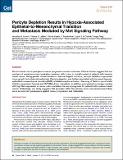| dc.contributor.author | Cooke, Vesselina G. | |
| dc.contributor.author | LeBleu, Valerie Sandra | |
| dc.contributor.author | Keskin, Doruk | |
| dc.contributor.author | Khan, Zainab | |
| dc.contributor.author | O’Connell, Joyce T. | |
| dc.contributor.author | Teng, Yingqi | |
| dc.contributor.author | Duncan, Michael B. | |
| dc.contributor.author | Xie, Liang | |
| dc.contributor.author | Maeda, Genta | |
| dc.contributor.author | Vong, Sylvia | |
| dc.contributor.author | Sugimoto, Hikaru | |
| dc.contributor.author | Rocha, Rafael M. | |
| dc.contributor.author | Damascena, Aline | |
| dc.contributor.author | Brentani, Ricardo R. | |
| dc.contributor.author | Kalluri, Raghu | |
| dc.date.accessioned | 2014-12-01T15:09:02Z | |
| dc.date.available | 2014-12-01T15:09:02Z | |
| dc.date.issued | 2012-01 | |
| dc.date.submitted | 2011-09 | |
| dc.identifier.issn | 15356108 | |
| dc.identifier.uri | http://hdl.handle.net/1721.1/91948 | |
| dc.description.abstract | The functional role of pericytes in cancer progression remains unknown. Clinical studies suggest that low numbers of vessel-associated pericytes correlated with a drop in overall survival of patients with invasive breast cancer. Using genetic mouse models or pharmacological inhibitors, pericyte depletion suppressed tumor growth but enhanced metastasis. Pericyte depletion was further associated with increased hypoxia, epithelial-to-mesenchymal transition (EMT), and Met receptor activation. Silencing of Twist or use of a Met inhibitor suppressed hypoxia and EMT/Met-driven metastasis. In addition, poor pericyte coverage coupled with high Met expression in cancer cells speculates the worst prognosis for patients with invasive breast cancer. Collectively, our study suggests that pericytes within the primary tumor microenvironment likely serve as important gatekeepers against cancer progression and metastasis. | en_US |
| dc.description.sponsorship | National Institutes of Health (U.S.) (NIH Grant CA125550) | en_US |
| dc.description.sponsorship | National Institutes of Health (U.S.) (NIH grant CA155370) | en_US |
| dc.description.sponsorship | National Institutes of Health (U.S.) (NIH Grant CA151925) | en_US |
| dc.description.sponsorship | National Institutes of Health (U.S.) (NIH Grant DK81576) | en_US |
| dc.description.sponsorship | National Institutes of Health (U.S.) (NIH Grant CA163191) | en_US |
| dc.description.sponsorship | National Institutes of Health (U.S.) (NIH grant DK55001) | en_US |
| dc.description.sponsorship | Champalimaud Foundation (Champalimaud metastasis programme) | en_US |
| dc.description.sponsorship | Champalimaud Foundation (Champalimaud investigator) | en_US |
| dc.description.sponsorship | National Institutes of Health (U.S.) (NRSA F32 Ruth Kirschstein Postdoctoral Fellowship from NIH/NIDDK (5F32DK082119-02)) | en_US |
| dc.description.sponsorship | National Institutes of Health (U.S.) (NIH Research Training Grant in Gastroenterology (2T32DK007760-11)) | en_US |
| dc.description.sponsorship | National Institutes of Health (U.S.) (NIH Research Training Grant in Cancer Biology (5T32CA081156-08)) | en_US |
| dc.description.sponsorship | United States. Dept. of Defense (DoD Breast Cancer Research Predoctoral Traineeship Award (W81XWH-09-1-0008)) | en_US |
| dc.description.sponsorship | National Institutes of Health (U.S.) (NIH Research Training Grant in Cardiovascular Medicine (5T32HL007374-30)) | en_US |
| dc.description.sponsorship | United Negro College Fund/Merck (Postdoctoral Science Research Fellowship) | en_US |
| dc.description.sponsorship | National Institutes of Health (U.S.) (NIH supplemental grant (CA125550)) | en_US |
| dc.language.iso | en_US | |
| dc.publisher | Elsevier B.V. | en_US |
| dc.relation.isversionof | http://dx.doi.org/10.1016/j.ccr.2011.11.024 | en_US |
| dc.rights | Article is made available in accordance with the publisher's policy and may be subject to US copyright law. Please refer to the publisher's site for terms of use. | en_US |
| dc.source | Elsevier | en_US |
| dc.title | Pericyte Depletion Results in Hypoxia-Associated Epithelial-to-Mesenchymal Transition and Metastasis Mediated by Met Signaling Pathway | en_US |
| dc.type | Article | en_US |
| dc.identifier.citation | Cooke, Vesselina G., Valerie S. LeBleu, Doruk Keskin, Zainab Khan, Joyce T. O’Connell, Yingqi Teng, Michael B. Duncan, et al. “Pericyte Depletion Results in Hypoxia-Associated Epithelial-to-Mesenchymal Transition and Metastasis Mediated by Met Signaling Pathway.” Cancer Cell 21, no. 1 (January 2012): 66–81. © 2012 Elsevier Inc. | en_US |
| dc.contributor.department | Harvard University--MIT Division of Health Sciences and Technology | en_US |
| dc.contributor.mitauthor | Kalluri, Raghu | en_US |
| dc.relation.journal | Cancer Cell | en_US |
| dc.eprint.version | Final published version | en_US |
| dc.type.uri | http://purl.org/eprint/type/JournalArticle | en_US |
| eprint.status | http://purl.org/eprint/status/PeerReviewed | en_US |
| dspace.orderedauthors | Cooke, Vesselina G.; LeBleu, Valerie S.; Keskin, Doruk; Khan, Zainab; O'Connell, Joyce T.; Teng, Yingqi; Duncan, Michael B.; Xie, Liang; Maeda, Genta; Vong, Sylvia; Sugimoto, Hikaru; Rocha, Rafael M.; Damascena, Aline; Brentani, Ricardo R.; Kalluri, Raghu | en_US |
| mit.license | PUBLISHER_POLICY | en_US |
| mit.metadata.status | Complete | |
